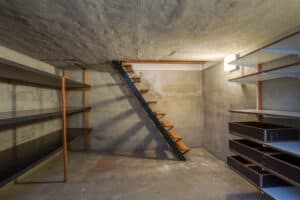
When you purchase a home, you will inherit either an oil or an electric heat system for the HVAC.
Sometimes the heating system you end up with ends up not being a good fit for you.
Luckily, you have the option of converting to a different type of heating system.
These conversions typically have an upfront cost, but in the end, you may feel as though you are going to save some money.
If you have been thinking about converting from oil to electric heat, we have all the information you need.
Average Cost of Converting from Oil to Electric Heat

The average cost of converting from oil to electric heat is going to be between $3,500 and $7,000.
Although this may seem like a wide range, your total price is going to be dependent on the size of your home and the size of the furnace you are purchasing.
You will also pay higher costs if you are located in a part of the country where the labor costs seem to be a bit higher.
There are some factors that you should understand prior to converting your home from oil to electric heat.
The excellent news about converting to electric heat is that most of the time, your yearly bills are going to be considerably lower than if you were to have oil heat.
Of course, oil prices are going to fluctuate a bit more than electricity prices, and this is something that should be considered when you are paying for the initial switchover.
Let’s look at some of the advantages and disadvantages of electric heat.
Advantages of Electric Heat

There are several critical advantages to electric heat.
Most of the time, when you switch to an electric system, you will be heating the entire house and not just one room with the electric heat.
One of the best things about electric heat is that it is relatively safe.
When you use oil heat, you need to worry about the fumes and gases that are created in the process.
With electric heat, this is not a concern.
There are no gases released by electric heat, and therefore, the chance of a family being poisoned by the heater is eliminated.
The other good thing about electric heaters is that there is no combustion.
This means that the chance of a house fire being started by your electric heater is going to be considerably less than it would be if you were using an oil heater.
Disadvantages of Electric Heat

There are, unfortunately, some disadvantages of electric heat.
If you are making the switch from oil to electricity, these disadvantages need to be understood and adequately considered.
If the disadvantages become too much, you may decide you want to stay with oil.
The most significant disadvantage of electric heat is that it is not very efficient.
If you live in a climate where you are going to be using the heat quite often, and it needs to be turned to warmer temperatures to keep the home warm, electric heating may be difficult.
It is a better idea to go with the oil because you will use much less oil.
Another problem with the electric heater is that the heat it puts out is also not nearly as warm as it is when it comes from oil.
These disadvantages can really make it difficult to switch all of your heating over.
It may make sense to calculate your potential energy costs before you make this decision.
There are, of course, ways to save money on electric heat and oil heat by conserving the amount of energy you consume in your home.
Advantages of Oil Heat

Before making your switch to electric heat, it is essential to consider the advantages of oil heat.
Oil heat certainly has some things that help it to stand out as the preferred method of home heating.
The major advantage of oil heat is that it is very efficient.
You need much less oil to produce even more heat than what an electric heater can produce.
This means that electric heaters need to run longer, and this will end up costing extra money.
In the end, they still struggle to heat the home in the same way that an oil heater can.
You will notice that when the days are very cold, and you need to try and keep the house warm all day, the oil will have no problem doing this, while the electric may struggle.
Oil can be delivered to a variety of locations, so in most areas of the country, having oil heat is not going to be an issue.
Oil can be delivered anywhere, including rural areas and remote locations.
How to Save Money on Heating Costs

Whether you are running oil or electric heat, there are always ways that you can save some money on your heating costs.
Sometimes making some slight changes to your normal routine and habits can be all that is necessary to save hundreds or thousands of dollars a year.
Here are a few of our favorite ways to start putting some dollars back into your bank account.
1. Dress Appropriately

We all assume that we wear jackets outside and when we come into the house, we should be able to wear whatever we want.
However, in the middle of the winter, it can make sense to put on an extra sweater while inside the house.
Sometimes this extra sweater can allow you to drop the thermostat by a few degrees.
Although this may not seem like a big deal, it will make a significant difference in the long run.
Wearing a sweater for a few hours instead of turning your heat up can save hundreds of dollars.
This is especially important to consider at night.
When it is nighttime and you are asleep in your bed, there is no reason to keep the heat on full blast.
The best idea is to put an extra blanket on your bed so that you can stay warm throughout the night.
We sleep for such a long time that simply decreasing the temperature just a few degrees at night will save so much energy.
This is another reason that a digital thermostat can make sense.
You can program the thermostat so that the temperature starts to increase again when you are going to wake up and get out of bed in the morning.
This is so that the air is not too cold when you get out of bed, yet you were still able to save money all night long.
Dressing appropriately is not hard to do, and you can find ways to stay comfortable and cozy while still saving a bit of money on your heating costs.
2. Turn Off When People Are Not Home

When you are going to be out of the house for the day, do you leave your heat on full blast?
Although you must watch out for issues with frozen pipes in some parts of the country, for the most part, the heat does not need to be left high while you are not home.
As long as your heat is set to a temperature that will keep the home warm enough to avoid any damage, you are fine to leave it.
For instance, if you are someone who leaves the heat on 70 degrees when you are at home, you can drop it to 60 when you leave for work.
Of course, the 6- degree temperatures will be a bit cold, but you won’t be there to worry about it.
If you purchase a digital thermostat, you could adjust the heat so that when you are on your way home from work, you can move it back up to the 70.
Therefore, you are never going to have to feel the colder temperatures, but you also don’t need to pay for the heat the entire day.
This is a great benefit and one that more and more people should be considering when they are using their heating systems in their homes.
3. Be Conservative About the Temperature

When it comes time to choose the temperature to heat your home to, it pays to be conservative.
As yourself, if it is possible, go one or two degrees lower in temperature for a month.
See if it is difficult for you or if you were able to adjust by adding an extra sweater and a pair of socks.
Check your heating bill at the end of the month and see what it looks like from a cost savings perspective.
Are the prices enough for you to make this a permanent adjustment in your life?
Most people will find that with both heating and air conditioning, you must be a bit more conservative about the temperature if you are planning to try and save money.
You won’t be able to make the inside of your home feel like a Florida beach and still be saving money throughout the winter.
Try to balance your need for heat with your need for money in your bank account.
4. Seal Off Openings Around Windows and Doors

Heat will find any way that it can to get out of your house.
If you want to make sure that you can heat your house for the lowest price possible, you need to check on the openings around your windows and doors.
If the windows and doors are all sealed, you will notice that your home is much more efficient.
The efficiency is decreased considerably when the heat can escape through these gaps.
If you don’t already have them, there are things that you can place at the bottom of your doors to make sure that heat cannot escape.
You can also replace the weather stripping around your windows to help keep heat in.
Although it is not nearly as effective, sometimes having curtains on your windows can also cause a bit less of the warm air to escape.
You can easily test some of these areas yourself as you walk around the home.
If you walk past a room and feel a draft, see if you can figure out why the room may be colder than others.
Always check the heating vents as well to see if they are properly pushing heat out into the right areas of the home.
Conclusion
In the end, the switch to electric heat is going to cost a few thousand dollars, and then you will pay about the same from year to year for your heating costs.
This pricing is going to always fluctuate a bit based on certain economic conditions.
Remember that regardless of the type of heating you have, you can always save money by following our tips.
Simply being a bit flexible with the temperatures at which you set your thermostat will help much more than you realize.



I would like to change my oil heating system to electric heating system